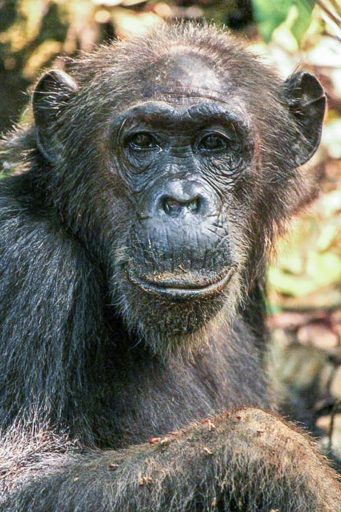- By studying decades of interactions, scientists have documented that female chimpanzees line up in a pre-determined social order.
- Females wait patiently for higher-ranked females to die off before moving up the social ladder.
- Once a mature female enters the social queue, her ranking remains unchanged until elder females are out of the picture.
Humans aren’t the only primates who jockey for higher social status and the rewards that go with it. Chimpanzees also compete for higher rank within their communities, and the accompanying access to better mates and meals. But that process, scientists have learned, is very different for males than for females.
A study published last month in Scientific Reports used an innovative method to analyze decades of chimpanzee interactions. Researchers were able to measure just how much these animals’ social status changed during their lifetimes.
Evolutionary anthropologist Steffen Foerster and his team at Duke University in the U.S found that female chimpanzees, unlike their male counterparts, rarely change their social status through direct competition. Instead, a female’s rank increases with age as she patiently waits for higher-ranked females to die off before moving up the social ladder.
“Ultimately, males have different priorities in terms of optimizing reproductive success,” Foerster said. “In one high-ranking year a male can fertilize a lot of offspring, even if he’s not the alpha [male] for very long.”
But females, it seems, play the long game.

“The only way females can maximize reproductive success is by living a long life and having as many babies as possible, which means they have be careful and minimize injuries,” Foerster said. “They’d rather forgo a slight increase in rank than jeopardize their health.”
So while male chimps often challenge higher-ups, female chimpanzee ranks remain relatively stable. Primatologists have noted these differences before, but no rigorous study has documented “queuing behavior”—where individuals take their place in line in a pre-determined social order—until now.
“It is nice to see this confirmed by a massive database on wild chimpanzees,” said Frans de Waal, a primatologist from Emory University in the U.S., who was not involved in the study.
Foerster’s team analyzed digitized records of almost 4,000 interactions between members of the Kasekela chimpanzee community in Tanzania’s Gombe National Park from 1969 to 2011. Jane Goodall drew from this same well of data to publish her own observations about chimpanzee social behavior nearly 40 years ago.
Scientists have tried to systematically assess these interactions since the Gombe field studies began. Yet not only are the data hard to collect—requiring continuous field observations of group compositions and their social exchanges—but the process involves uncooperative subjects. Females spend much of their time alone or with offspring, rarely interacting with one another. This leaves researchers with few encounters to examine.
Foerster’s approach, however, allowed the team to scrutinize interactions over the entire life spans of chimpanzees—45 years, on average. Previous methods had restricted such analyses to two-year blocks of times.

An existing rating method calculates the relative ranking of individuals in a competitive environment. Foerster’s team developed a new variable that included the likelihood a chimpanzee would be able to dominate another individual during each unique interaction. This allowed the team to better calculate an initial ranking for each chimpanzee in the community.
By studying 2,741 interactions from 22 adult males, the team found that males frequently gained and lost rank. In contrast, an examination of 1,015 interactions from 44 adult females revealed that challenges to each other’s rankings were rare. Instead, females formed stable dominance relationships with one another.
This work represents a major step forward in understanding how dominance arises and shifts within each sex, said Andreas Koenig, an anthropology professor at Stony Brook University in New York. Koenig is interested to see how Foerster’s approach might apply to studying dominance hierarchies in other animals. “This new method may allow us to better compare similarities and differences across species and sexes,” he said.
Foerster now hopes to explore how female chimpanzees attain their entry rankings in the social queue. His current study shows that once a female enters at age 12, her position remains largely unchanged. But this starting rank, and the number of peers a newly entering female can “jump over” in line, varies widely. To date, the team has seen one clue: having a mother that is still alive in the community leads to significantly higher entry ranks.
“All we know is once they enter, they’re stuck in the queue,” said Foerster. “So it’s all they can do to not enter at the bottom.”
Citation:
Foerster, S., Franz, M., Murray, C.M., Gilby, I.C., Feldblum, J.T., Walker, K.K., and Pusey, A.E. (2016). Chimpanzee females queue but males compete for social status. Scientific Reports 6 (35404). doi: 10.1038/srep35404.
Aylin Woodward is a graduate student in the Science Communication Program at the University of California, Santa Cruz. Other Mongabay stories by UCSC students can be found here.
